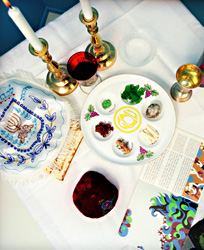Five Easy Steps To A Seder Everyone Can Enjoy
After countless hours cleaning, koshering and cooking, everyone looks forward to the Pesach seder. The seder is the 15-step ritual dinner which recounts the Jews’ exodus from Egypt. One of the most central events in the Jewish faith, the seder features a mouthwatering plateful of symbolic foods, the gripping story of slavery and redemption from bondage (retold in the Haggadah), ten plagues, four questions and hours of singing and eating.
most central events in the Jewish faith, the seder features a mouthwatering plateful of symbolic foods, the gripping story of slavery and redemption from bondage (retold in the Haggadah), ten plagues, four questions and hours of singing and eating.
Yet despite the great anticipation for the seder, many participants are often left feeling uninspired. Maybe the liturgical introduction wears everyone out, when they just want to eat already! Perhaps the seder leader rushes through the stories, practically mumbling them under his breath just “get it over with”. Either way, everyone is missing out on the special meaning of this seminal day.
Don’t fall into the trap of hosting some less-than inspirational family dinner party devoid of any spiritual significance. Try some of the following tips and tricks to infuse your family seder with enjoyment and meaning. Make it a seder guests of all ages can enjoy.
#1. Act Like Royalty
Explain to everyone that on seder night, they are like kings and queens. Since royalty never have to serve themselves, pair up your guests and ask each one to take charge of pouring for and serving the other.
Reinforce the theme by making paper crowns for your guests – at least the young ones. Or use a crown (or sceptor) stencil to create place settings and napkin ring holders. (P.S. This is a great activity to engage your own little ones in while you rush around finishing the seder cooking.)
#2 Ten Plagues In A Bag
Look around your home or scour the dollar store in search of visual aids for the 10 Plagues. Wrap them up in a brown paper bag and give one to each guest – or at least to each child. You can ask the kiddos to be your partners in crime, instructing them to secretly stash their bags until the 10 Plagues are recited. Then they can suddenly rain blood, boils and beasts down on your table. Look for plastic frogs, cows and “beasts” (tigers and bears will suffice), a pair of sunglasses for the darkness, some fake/costume blood and even a few tiny Styrofoam balls to represent the hail.
#3 Haggadahs for Everyone
First, make sure everyone has a copy of the same Haggadah, so no one is fumbling around to find the right page. Chose Haggadahs that include English and Hebrew text, so that everyone can read in the language they are most comfortable. Go around the table, asking everyone to read a paragraph or two. Involve those children who can read, as well – don’t just wait for the 4 Questions! For pre-readers, make a coloring book Haggadah, where each of the 15 steps of the seder are represented by a picture (a quick Google search turns up plenty of coloring sheets). Place the coloring book and a packet of crayons at each little one’s place, to help keep them occupied during the pre-dinner reading.
#4 Encourage Questions
Take a break in the reading to engage some discussion. Help make the meaning of the Haggadah more relevant to your guests by asking them to prepare modern stories about the meaning of freedom in our world today. Ask them to contemplate what it means when the Haggadah says that no Jew maybe free if any Jew is enslaved. If your guests are mostly adults, you can even hand out a sheet of questions to be tackled in small groups. After 5 or 10 minutes, call everyone back to the table and open up a lively discussion with your guests’ input.
#5 Come Prepared
Ask your guests to eat a light meal before coming to your seder so they won’t be starving – and distracted from the Haggadah. Prepare snacks for children, and set them up at a small side table, together with some age appropriate craft activities. If your young guests are old enough to play independently, engage them in writing a song or sketch about Pharoah and baby Moses or the crossing of the Red Sea.
With a little planning and some clever creativity, you can host a seder that everyone talks about for years to come. And not just because of your grandmother’s famous recipe for matzah ball soup, but because you helped connect them to one of the most important events in Jewish history.



